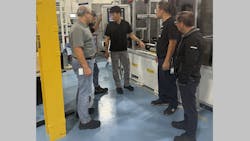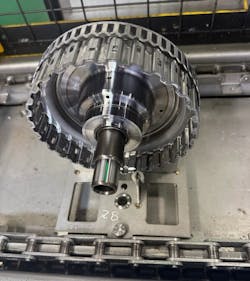2025 IndustryWeek Best Plants: Culture-Driven Manufacturing Excellence Propels Pullmatic Mfg. Magna Powertrain
Key Highlights
- Pullmatic Mfg. Magna Powertrain emphasizes servant leadership and open-door communication, including weekly culture meetings and daily interactions between management and employees to foster trust and engagement.
- Five years ago, this plant produced components only for vehicles powered by the internal combustion engine. Since then, it has begun marching into new areas as well, taking on the challenges presented by both hybrid and electric vehicles.
- Continuous improvement initiatives include layout optimizations, Industry 4.0 data collection, and employee suggestion programs.
New pieces of equipment are already in place in a sectioned-off area of Pullmatic Mfg. Magna Powertrain Inc., and more are on the way. That’s where the new Rivian line is going in. Excitement about the incoming business fuels discussions around the manufacturing process, training, prototyping and launch schedules.
On any given weekday, activity hums on the manufacturing plant floor, where the automotive supplier’s workforce routinely produces transmission components for a global customer base. Yet the buzz around the Rivan line is just a bit louder.
Five years ago, this Pullmatic facility, located in a suburb about 19 miles north of downtown Toronto, produced components only for vehicles powered by the internal combustion engine. Since then, it has begun marching into new areas as well, taking on the challenges presented by both hybrid and electric vehicles.
The advance into new areas isn’t surprising. In fact, you could call it routine. “We’re always striving for the next thing,” says general manager Jose Melo.
Pullmatic has coupled the facility’s can-do attitude with a culture that prizes employee engagement, practices servant leadership and cranks out performance measures that any manufacturer would envy. For these reasons and more, the IW Best Plants judges are pleased to select Pullmatic Mfg. Magna Powertrain in Markham, Ontario, as a 2025 IndustryWeek Best Plants Award winner.
Pullmatic Mfg. Magna Powertrain Inc.
- Markham, Ontario, Canada
- Employees: 152
- Total Square Footage: 100,000
- Primary Product: transmission components
- Start-up Date: 1985
- Achievements: More than 2,000 days without a lost time accident; Magna Safety Excellence Awards 2019, 2020, 2021, 2022, 2023, 2024 and 2025, as well as a slew of supplier and quality awards from automotive OEMs over the years; ISO 45001 certified; ISO 14001 certified; 80% of workforce participates in empowered or self-directed teams
Communication and Servant Leadership
Pullmatic operates in the powertrain division of global automotive giant Magna International. Roller die spline forming, stamping and welding assembly are among the processes underway within the walls of the unassuming Markham building, where a team of 152 employees come together to achieve performance metrics such as 99% first pass yield for all finished products, 100% on-time delivery based on the customer request date, and more than 2,000 days without a lost-time accident.
At Pullmatic, conversation around operational excellence begins and ends with culture. The right culture builds success. The wrong culture limits opportunities.
To that end, Pullmatic began doubling down on its engagement efforts about four years ago. Not that it was bad then, “but culture is never good enough,” says the general manager.
Central to the culture is servant leadership, which emphasizes a leadership focus on nurturing employees’ growth and well-being.
“Our job is to make sure people have what they need,” says Melo. “If I do my job right, I will know what they [the employees] need before they even ask.”
It is a culture built on the belief that you can never communicate enough, and face-to-face communication is invaluable. For this reason, the team has deliberately built a variety of routes to foster improved workplace communication and engagement. Two such efforts include:
- Weekly culture meetings: Human resources members meet with small groups of shop-floor employees to discuss, well, pretty much anything. The conversation may be about a concern over something a supervisor said. It may be about an improvement idea. It may be positive feedback about a recently implemented process that is working well or consternation about new packaging that is creating a manufacturing issue. The HR team takes the shop floor issues, summarizes them and shares the concerns with the leadership team, assigning champions to address each issue—also providing feedback to the shop floor group.
- One hour per week: Department managers must spend one hour a week speaking with different operators on the shop floor. While the interactions find their way to “How can I help you solve a problem or remove an obstacle?” they start from a more casual place, such as “How are you? How is the family?” The goal isn’t simply to uncover workplace concerns. The bigger piece is to make employees comfortable with speaking freely and to encourage trust between management and employees. Like the weekly culture meetings, there is a formal structure around the process.
Human resources manager Daljit Banwait describes these engagement efforts as part of the plant’s “open-door process.”
“That means employees can speak to anyone. We have multiple avenues which employees can use if they have any questions, issues or concerns. … Our door is open.”
The organization’s efforts have borne fruit: Pullmatic achieved the highest engagement score among Canadian Magna plants in the company’s recent employee opinion survey.
People Development
Not surprisingly, the open communication philosophy extends to Pullmatic’s robust orientation process for new hires. While many components of the orientation likely are typical of what you find in many organizations, two stand out. One is the buddy system. New hires are assigned a “buddy,” who serves both as a training resource and someone to whom new hires can go with questions.
Where’s the GPS?
Pullmatic leadership team members joke at times that they should attach a GPS to Jose Melo, a 53-year veteran of Magna who has led the Markham manufacturing plant for the past five years. Not only does the general manager enjoy spending time on the shop floor, but the jest reflects how Melo is known to operate from different desks scattered around the shop floor, depending on where attention is needed.
“Sometimes trying to find him … we have to walk the shop floor to find exactly where he is sitting today,” says Daljit Banwait, human resources manager. The plant floor workers love it, she adds. “They actually made comments that he's the first GM they have ever seen who is sitting on the shop floor.”
A visit to the shop floor is typically Melo’s first stop of the day when he gets into the manufacturing plant, and he can get in very early. “He tries to walk the floor every shift,” to learn what’s going on, or not going on, and he likes to hear it directly from the source, Banwait says. “He’s doing ‘walk the talk.’ So, if he expects managers to be on the shop floor, he does it.”
Melo’s background may provide some insights into both his joy of the plant floor as well as his keen interest in improving workplace culture. Melo has a degree in psychology as well as a diploma in philosophy (plus a few others). Moreover, his career with Magna began in 1972, where he worked his way up from a machine operator to eventually lead multiple plants in his long career.
“I dedicate a significant amount of time to mentoring individuals globally,” says Melo in his bio. “I am passionate about developing and inspiring people, helping them reach their full potential.”
The other is performance appraisals. New employees receive three performance appraisals in their first three months on the job: the first after one month, a second after two months and a third after three months. Then the cadence moves to annual reviews.
The early reviews are not about finding fault or laying blame. They instead are about setting up the new hire for success by checking in and addressing concerns (by the manager and employee) early and often—not waiting three months and springing a surprise on either party.
“It gives us the chance to sit down and discuss things after one month,” Banwait explains. “The second month, if [the new employee has] the same issues, then the manager should be thinking, ‘Okay, what is not working? What is happening here?’” And how do we fix it?
“We make sure we invest the time in hiring and training,” adds HR coordinator Tania Prashar.
The new hire and orientation process is part of Pullmatic’s bigger people-development process, which emphasizes growth opportunities and talent development.
Sarjak Patel and Jacob Ham are prime examples of talent development at work. Pullmatic hired Ham approximately three years ago as a project engineer. Upon joining the manufacturer, Ham continued his education, with a focus on program management. When the opportunity to become program manager for the Rivian line opened up, he was ready to step up.
“We gave him all the tools and he took those tools and ran,” Melo says.
Patel, a senior manufacturing engineer, started with Pullmatic approximately seven years ago as a temporary CNC operator working the night shift while he pursued courses as an international student. He transitioned to a full-time operator, later a machinist, got promoted to a junior quality engineer and then quality engineer. In 2022 he moved into a manufacturing engineer role and in 2024 was promoted to senior manufacturing engineer.
Banwait said Patel’s “interest and dedication and accountability” captured Pullmatic’s attention early on, which prompted inquiries into his career goals and placement in the manufacturer’s talent management program.
“If you want to be successful, you have to develop your people,” Melo says.
Continuous Improvement Mindset
No story about an IW Best Plants winner is complete without a conversation about continuous improvement. As part of the larger Magna organization, Pullmatic’s continuous improvement efforts are guided by the Magna Factory Concept, or MAFACT, a set of global guidelines for continuous improvement.
Continuous improvement specialist Rupinder Sains, who is also the division’s MAFACT champion, guides Pullmatic’s operator training for standardized work, 5S, Training Within Industry and more.
“She is also our ‘train the trainer’ and she provides training to everyone,” Banwait adds.
Signs of improvement activities abound across the plant floor, where in one location a team is making layout changes to a production line to save both space and labor. Two employees from that line will transition to the Rivian line.
In another area, engineers are unpacking their belongings in an office adjacent—and closer—to the factory floor. Not only does the new home speed their response time to calls for assistance from operators, but “on the shop floor you learn,” Melo remarks.
Overhead, the plant recently installed an air-handling system to both help cool and heat the production floor. And across the plant, an Industry 4.0 initiative is underway to connect all the equipment, collect live data and introduce condition-based monitoring.
Move into the lunchroom and you will find the employee suggestion box. Employees must submit a minimum of two improvement suggestions per year, with small prizes awarded monthly in several submission categories. Management has responsibilities here as well, reflective of Pullmatic’s open-door process.
Every day a “fast response” team meets to review the suggestions and assign a champion—typically a department head—to each one. Champions must provide feedback to the employee who made the suggestion within seven days. It’s important that employees know they are being heard.
“To be successful, you have to have workforce engagement,” says Melo. “Once you have that, the sky’s the limit.”
About the Author
Jill Jusko
Bio: Jill Jusko is executive editor for IndustryWeek. She has been writing about manufacturing operations leadership for more than 20 years. Her coverage spotlights companies that are in pursuit of world-class results in quality, productivity, cost and other benchmarks by implementing the latest continuous improvement and lean/Six-Sigma strategies. Jill also coordinates IndustryWeek’s Best Plants Awards Program, which annually salutes the leading manufacturing facilities in North America.
Have a story idea? Send it to [email protected].


